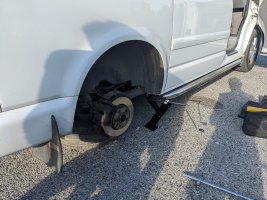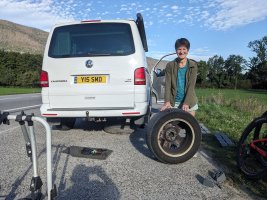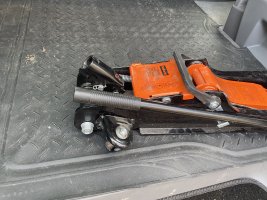Ocean Spirit
Eating Ice Cream, skimming stones.
Super Poster
Changing a wheel for the spare?
What you might want to know as these things happen.
I’ve had 2 punctures and I’m on my 2nd set of tyres on a van I bought from new so regardless of the fact I’m the first owner I think the conditions can relate to average usage for owners.
Do you know if your wheels are bonded to the disc mount surfaces?
Do you have & know what condition your locking nut and bolts are in?
Do you have a spare (checked its not been stolen)?
If you’ve driven it flat on the rim for any distance forget the chances of repair.
If you have the time there and then get your breakdown service to complete the job.
What you might want to know as these things happen.
I’ve had 2 punctures and I’m on my 2nd set of tyres on a van I bought from new so regardless of the fact I’m the first owner I think the conditions can relate to average usage for owners.
- The first time a wheel had been off since Picking up the California from the dealers was for a puncture in a car park and I left it to VW assist to do as I shopped which was actually the AA. I returned to see the technician they sent had a real difficult time in removing the wheel once it was jacked up as the dissimilar metals had bonded through corrosion. With a hefty rubber mallet and the van rocking while on a 3 ton jack it eventually came free. So the next service I asked if VW dealer would remove all 4 wheels and refit them for which they originally wanted a handsome price. I declined, raised my concerns about how someone might get on with the VW tool kit in the dark and why on a busy bend. SCARY! I was able to get a result. The spare wasn’t used.
- Once this had been done (and I have no idea how ‘stuck’ the 3 remaining wheels were) the wheels came off seemingly easy when a new set of tyres went on. So I wonder if the bonding of dissimilar metals is somewhat passivated once the bond is broken from factory new and clean environments. The spare still hadn’t been used.
- With the California approaching 50k and advisories on the previous MOT I employed the help of a friend and we changed 4 discs and all pads. We had no issue removing the wheels so either we were unlucky with the 1st wheel from factory or my guess about the initial bond holds some worth.
- Now with a 6 year old vehicle I collect my 2nd puncture, the same wheel as the 1st one (Drivers side front) and this time its pouring down this and I have to get out of traffics way somehow. Fortunately not overly busy I’m able to pull into a carpark after driving really slowly for about 1 tenth of a mile. With the rain easing, while waiting for the RAC this time I need to use the spare to limit my journey delay so I start to do the things I used to have to. I get the tool kit out of the boot area and loosen the wheel nuts. The locking bolt looked fine and the locking nut did too. But rather than use that emergency jack and the patrol only 10 minutes away I refrained from attempting using it deciding to wait for him. But I did use the socket bar to undo the spare wheel carrier and get that out from under the vehicle. Its not overly difficult even in those weather conditions but its heavy, make sure you removing the one thats not in the slot completely and fully loosen the captured on in the slotted hole. You need to drag the securing arm across (self explanatory when doing it) to the open end and the weight of the wheel takes over so be careful. I found it to be a full size steel wheel when I was expecting a space saver so a pleasant surprise. But also a nasty surprise when you see how rusty the thing has got sitting under your pride and joy for 6 years. With the RAC now in attendance and the hard work done for him he jacked it up and swapped the wheels over. In a hurry I decided it was best to do up the wheel carrier empty and leave the punctured wheel/tyre in the living area on plastic bags.
- The RAC tech asked me to check the wheel nut tightness after 100 miles if the spare was still being used because of the rust/corrosion at the bolt holes on the spare.
- Nearly a week passed and I took the puncture to a tyre place who declared it repairable by its location only to find my tenth of a mile journey had ruined the inner wall of the Michelin Crossclimate. £180 later a new tyre was fitted and this particular model is directional so they need to know what side the wheel is going back on.
- This morning fitting the new tyre I found the wheel nuts much tighter than by the roadside that day when I got the puncture (with the same socket bar) and worse still the locking nut and locking wheel bolt both exhibited some damage. I’m sure this was done by the Tech but can’t prove it so I’m not even going there. But what it did mean was the tools I had stood a real chance of making things worse so I invested in a breaker bar (should have done this years ago) and it prevented any further damage to the bolt and locking nut due to the grip and leverage you can get without slipping.
- I put the spare back in the carrier. Thats more tricky even in much better conditions with no stress going on. Theoretically its a reversal of the removals steps of course but alignment and weight are the pigs! Make sure you loosen the captive bolt completely don’t be lazy.
Do you know if your wheels are bonded to the disc mount surfaces?
Do you have & know what condition your locking nut and bolts are in?
Do you have a spare (checked its not been stolen)?
If you’ve driven it flat on the rim for any distance forget the chances of repair.
If you have the time there and then get your breakdown service to complete the job.
Last edited:

















